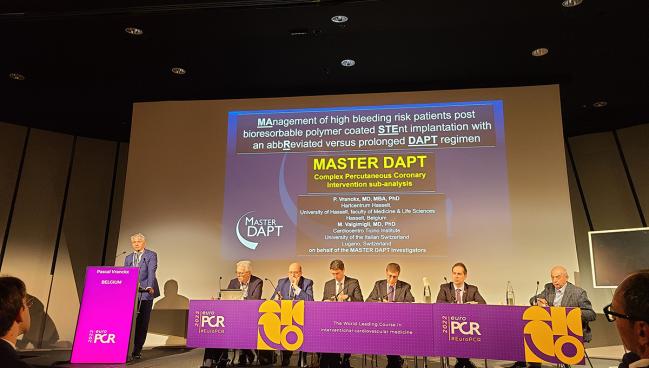Shorter DAPT Sufficient Even in Complex HBR Patients: MASTER DAPT
Complex HBR patients had the most to gain from longer DAPT, but even here, the shorter regimen seemed to hold up.

PARIS, France—One month of dual antiplatelet therapy (DAPT), compared with 3 months or longer, is sufficient for PCI patients at high bleeding risk (HBR) regardless of procedural complexity, according to a subanalysis of MASTER DAPT.
In the ongoing quest to define optimal DAPT duration following PCI, these data indicate that even complex patients at higher risk of bleeding may not require a longer course of treatment than their noncomplex counterparts, researchers say. The findings are in line with the original MASTER DAPT results, presented last year at the European Society of Cardiology meeting and published in the New England Journal of Medicine.
In fact, during a press briefing at EuroPCR 2022, Marco Valgimigli, MD, PhD (University of the Italian Switzerland, Lugano), told TCTMD it’s likely that past studies of longer-term DAPT, such as PEGASUS-TIMI 54, “clearly overtreated” these patients by putting them at “threefold higher bleeding risk and no signal of benefit.”
One-month DAPT in HBR patients is now “standard of care that I'm implementing more and more in my practice with the caveat of stent thrombosis and in-stent restenosis,” Valgimigli continued. For the latter groups, he bases his decision-making around dual drug duration on a patient's individual bleeding risk.
But commenting on the study for TCTMD, David Kandzari, MD (Piedmont Heart Institute, Atlanta, GA), said in the United States, physicians are “very much compelled to prolong dual antiplatelet therapy for high-bleeding-risk patients with complex disease” with the thought that this will reduce events.
“Many practitioners are, rather than proactively stopping dual antiplatelet therapy and transitioning to single antiplatelet therapy, instead waiting for the bleeding event to occur and then going to single antiplatelet therapy,” he said. “Or alternatively—and maybe to be fair, more commonly—treating patients for longer durations of 6 months or 1 year, whereas [in the past] they might have prolonged it for 12 months or a lifetime for those particular patients instead.”
HBR Patients
For the subanalysis, presented today at EuroPCR 2022 by Pascal Vranckx, MD, MBA, PhD (University of Hasselt, Belgium), and simultaneously published in the European Heart Journal, the researchers used the Giustino criteria to define complex PCI, including at least one of the following:
- Three vessels treated
- Three or more stents implanted
- Three or more lesions treated
- Bifurcation with two stents implanted
- Total stent length > 60 mm
- Chronic total occlusion as the target lesion
The slightly more than one-quarter of the total study population considered to be complex had similar NACE (all-cause death, MI, stroke, and major bleeding), MACCE (all-cause death, MI, and stroke), and major or clinically relevant nonmajor bleeding outcomes at 1 year compared with the noncomplex patients.
One-Year Outcomes
|
|
Complex |
Noncomplex |
|
||
|
|
HR |
95% CI |
HR |
95% CI |
P for interaction |
|
NACE |
1.03 |
0.69-1.52 |
0.90 |
0.71-1.15 |
0.60 |
|
MACCE |
1.24 |
0.79-1.92 |
0.91 |
0.69-1.21 |
0.26 |
|
Major or clinically relevant nonmajor bleeding |
0.64 |
0.42-0.98 |
0.70 |
0.55-0.89 |
0.72 |
The results remained consistent when the researchers used more-comprehensive definitions of complex PCI as well as in complex PCI and/or ACS and complex PCI and ACS populations, Vranckx reported.
Strategy Change
Discussing the findings, panelist Petr Widimský, MD, DrSc (Charles University, Prague, Czech Republic), said the study will enable him to wait until a month after PCI to decide on a DAPT strategy, as opposed to choosing an option immediately following the procedure, as he has been doing. “This could be a complete change of our strategy,” he said.
Similarly, panelist Eliano Navarese, MD, PhD (Nicolaus Copernicus University, Bydgoszcz, Poland), said “this study's a practical exemplification of reality in a conundrum on the patients we see daily.” While the margin of noninferiority used here is “relatively large,” he added that he is confident in the findings because of the large sample size.
It will likely take more to convince US physicians. “What it would take to transition practice in the United States would be greater education among the noninterventional cardiovascular community,” Kandzari predicted. “The awareness of shorter-duration trials in the interventional space is increasing among the interventional cardiologists, and I still would say there's a lot of opportunity for education there, but certainly that hasn't translated beyond the interventionalists to the broader cardiovascular community, at least in clinical practice.”
Additionally, because interventional cardiologists tend to be involved more in follow-up care in Europe than in the United States, this could explain some of the discrepancy, Kandzari added.
As for the variability in how complex PCI, as well as high bleeding risk, can be differently defined in clinical practice, he said it might not be that big of a deal since doctors rely on “more of a gestalt or a perception” as opposed to hard and fast criteria when managing care. “Lesion complexity differs because of variability in interventionalists' interpretation of the angiogram and their skill sets, too.”
“Are there always going to be one-off cases where people are going to think that this is really not a complex lesion or it is a complex lesion?” Kandzari asked. “To be sure that will occur, but I think that those types of lesion characteristics, there's good consensus across the interventional community that those would qualify as such.”
Next, Kandzari would like to see more work looking at what the ideal agent is when transitioning to single antiplatelet therapy. “Aspirin therapy confers its own individual bleeding risks because of its irritative effects on the GI tract,” he explained. “Clopidogrel has a lower risk of bleeding. More-potent ADP antagonists or P2Y12 inhibitors prasugrel and ticagrelor might confer a higher bleeding risk.”
Lastly, because MASTER DAPT involved use of the bioresorbable Ultimaster stent (Terumo), which is not commercially available in the United States, both the researchers and Kandzari say the findings cannot be applied to patients who receive different stents.
“Many doctors would say this is a class effect, that it's not related to the stent, that the trial results stand on their own with regard to the duration of dual antiplatelet therapy,” Kandzari said. “I still feel in many ways that each stent needs to be held to its own standards just based on early lessons with early-generation drug-eluting stents, that it's not a class effect. . . . Whether it's translational to other drug-eluting stents, I think, to be fair, has to be proven.”
CRUZ-HBR
Also during the session, David Leistner, MD (Charité – University Hospital Medicine, Berlin, Germany), presented results of the CRUZ-HBR study, which showed noninferiority of the sirolimus-eluting Supraflex Cruz stent (SMT; Surat, India) with regard to the composite endpoint of CV death, non-target-vessel MI, and clinically driven TLR compared with the biolimus DCS in 466 HBR patients at 1 year.
Interestingly, BARC type 3 to 5 bleeding was reported in 5.9% of HBR patients at 1 year—significantly more than the 0.7% in the non-HBR patients (P = 0.001)—even though only 23.8% of them were still on DAPT at 12 months (52.3% of the non-HBR patients remained on DAPT).
At this point, panelist Hany Eteiba, MD (Nuffield Health, Glasgow, Scotland), said, it would not be worth revisiting the DAPT guidelines for HBR patients yet. “For high-risk bleeding, it is very challenging in that it will increase proportionately because of that increasing aging population and comorbid conditions, etc,” he said. “Therefore, it is difficult to extrapolate when you randomize a specific stent with biodegradable polymer versus no nonbiodegradable polymer, this is no polymer whatsoever. And then you've got prasugrel and you've got aspirin, you've got clopidogrel. I think it's difficult to extrapolate.”
For co-moderator Chaim Lotan, MD (Hadassah-Hebrew University, Jerusalem, Israel), “the take-home message is the importance of late bleeding. We as cardiologists are very worried for the subacute thrombosis, which is less than 1% in most cases, but once we see 6% of major, major bleeding, I think it underestimates the importance of the 1% subacute thrombosis. We have to be more worried about the late bleeding complications than about the early results. And I think that all of us should be rethinking how to manage the long-term treatment in those patients.”
Yael L. Maxwell is Senior Medical Journalist for TCTMD and Section Editor of TCTMD's Fellows Forum. She served as the inaugural…
Read Full BioSources
Vranckx P. Management of high bleeding risk patients post bioresorbable polymer coated stent implantation with an abbreviated versus prolonged DAPT regimen. Presented at: EuroPCR 2022. May 17, 2022. Paris, France.
Leistner D. CRUZ-HBR: a prospective, multi-centre, all-comer registry on 1203 patients including 466 with high-bleeding risk. Presented at: EuroPCR 2022. May 17, 2022. Paris, France.
Disclosures
- Vranckx reports receiving consulting fees from Daiichi Sankyo, Novartis, CSL Behring, and Bayer AG; receiving honoraria from Daiichi Sankyo and Servier; and participating on an advisory board for Daiichi Sankyo.
- Valgimigli reports receiving research grants from ECRI, SMT, and Terumo Interventional Systems; and receiving honoraria or consultation fees from Abbott, Alvimedica, Amgen, AstraZeneca, Biotronik, Boston Scientific, Chiesi Farmaceutici, Daiichi Sankyo, Medtronic, and Vesalio.
- Leistner reports receiving honoraria from Abbott Vascular, Boehringer Ingelheim, Boston Scientific, SMT, AstraZeneca, Daiichi Sankyo, Shockwave Medical, Novartis, Bayer AG, Amgen, and B. Braun; and receiving research funding from Medis, Abbott Vascular, BMBF, DZHK, Novartis, SMT, GBA, Bayer AG, and AstraZeneca.
- Kandzari reports receiving research grants from Medtronic.
- Navarese reports receiving research grants from Abbott.
- Lotan and Widimský report no relevant conflicts of interest.





Comments